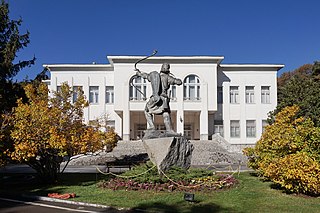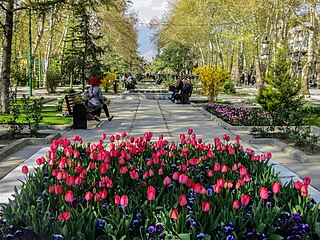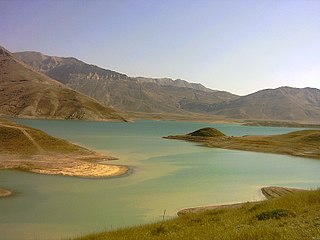Related Research Articles

Tehran is the capital and largest city of Iran and the largest city in Tehran Province. It also serves as the capital of the province, county and the Central District. With a population of around 9 million in the city and around 16 million in the larger metropolitan area of Greater Tehran, Tehran is the most populous city in Iran and Western Asia, and has the second-largest metropolitan area in the Middle East, after Cairo. It is ranked 24th in the world by metropolitan area population.

The Golestan Palace, also transliterated as the Gulistan Palace and sometimes translated as the Rose Garden Palace from Persian language, was built in the 16th century, renovated in the 18th century and finally rebuilt in 1865. It is the former official royal Qajar complex in Tehran.

The Sa'dabad Complex is a 110 hectare complex built by the Qajar and Pahlavi monarchs, located in Shemiran, Greater Tehran, Iran. Today, the official residence of the President of Iran is located adjacent to the complex.

Mellat Park, literally the Nation Park, is an urban park in northern Tehran, Iran.

The National Museum of Iran is located in Tehran, Iran. It is an institution formed of two museums; the Museum of Ancient Iran and the Museum of Islamic Archaeology and Art of Iran, which were opened in 1937 and 1972, respectively.

Valiasr Street, formerly known as the Pahlavi Street, is a tree-lined street in Tehran, dividing the metropolis into western and eastern parts which were built in 1922 to 1927 respectively, considering the end of asphalt plan it ended in 1933. It is considered one of Tehran's main thoroughfares and commercial centers. It is also the longest street in the Middle East, and was reported as one of the longest in the world by former BBC journalist Rageh Omaar during the television documentary Welcome to Tehran.

Amir Abad is a district in the city of Tehran, Iran.

Niavaran is an affluent and upperclass district in the north of Tehran. Bordering leafy, uphill-winding Darband Street, it can be reached from Tajrish Square, and is close to Darabad at the far north-eastern corner of Greater Tehran.

Pasdaran is a neighborhood of northern Tehran centered on Pasdaran Avenue. This avenue connects Niavaran avenue to Shariati avenue. It is about 8–9 km long and is a major commercial thoroughfare for northern Tehran together with northern parts of two other long streets: Valiasr Street and Shariati Street.

Farmanieh is a wealthy district located in northern Greater Tehran in the area named Shemiran. It lies within Shemiranat County and also district one of Tehran Municipality. Farmanieh has one of, if not the highest household income rates in Tehran, being home to many embassies, nobles and notables of Iran.

The Shahid Shiroudi Stadium formerly known as Amjadiyeh Stadium is a sports stadium in Tehran, Iran. It is currently used for athletics and held football matches until 2009.

Jamshid Bahman Jamshidian, also known as Arbab Jamshidi, was a prominent Zoroastrian figure in Iran who introduced the idea of modern banking in Iran as well as being the first representative of the Zoroastrian community in the Iranian Parliament.

Lavizān is a north-eastern neighborhood of Tehran, the capital of Iran.

Lar Dam is a dam located at the foot of Mount Damavand in Amol county, Mazandaran, Iran. The dam is located within the protected Lar National Park, and situated just 70 kilometers northeast of the capital and the most populous city of the country, Iran. The primary purpose of the dam is municipal water supply to Tehran but prior to the water reaching the city filtration plant, it is used to power the Kalan and Lavarak Hydroelectric Power Stations, with a combined installed capacity of 162.5 MW.

Behrouz Gharibpour is an Iranian theatre director and pioneer of traditional Persian puppet theatre.

Gholam-Reza Nikpey, also Nikpay was deputy prime minister of Iran and Mayor of Tehran. He became Mayor of Tehran in 1969, succeeding Javad Shahrestani. Prior to that, he had served as Iran's Minister of Housing from 1966 to 1969. During his tenure as the Housing Minister, an earthquake rocked the Province of Khorasan, causing mass destruction. He was in charge of rebuilding. It turned out to be one of the best rebuilding projects in the country's history. In 1977, he was appointed to the Iranian Senate by the Shah.

Iran's nuclear program is made up of a number of nuclear facilities, including nuclear reactors and various nuclear fuel cycle facilities.

The University of Science and Culture is a public non-profit university located in Tehran, Iran. University of Science and Culture is a research institution comprising college of engineering, science and art, offering both undergraduate and postgraduate studies.USC is one of the largest and most prestigious of the non-governmental universities in Iran.

The Iran Broadcasting University formerly known as the Iran Broadcasting College is a public university in Tehran, Iran. It is affiliated to I.R.I.B and also has campuses in Qom.
Bahar is a neighborhood area in Tehran, Iran. The name is taken from the name of the street that runs from Enqalab to Bahar-e-Shirazi.
